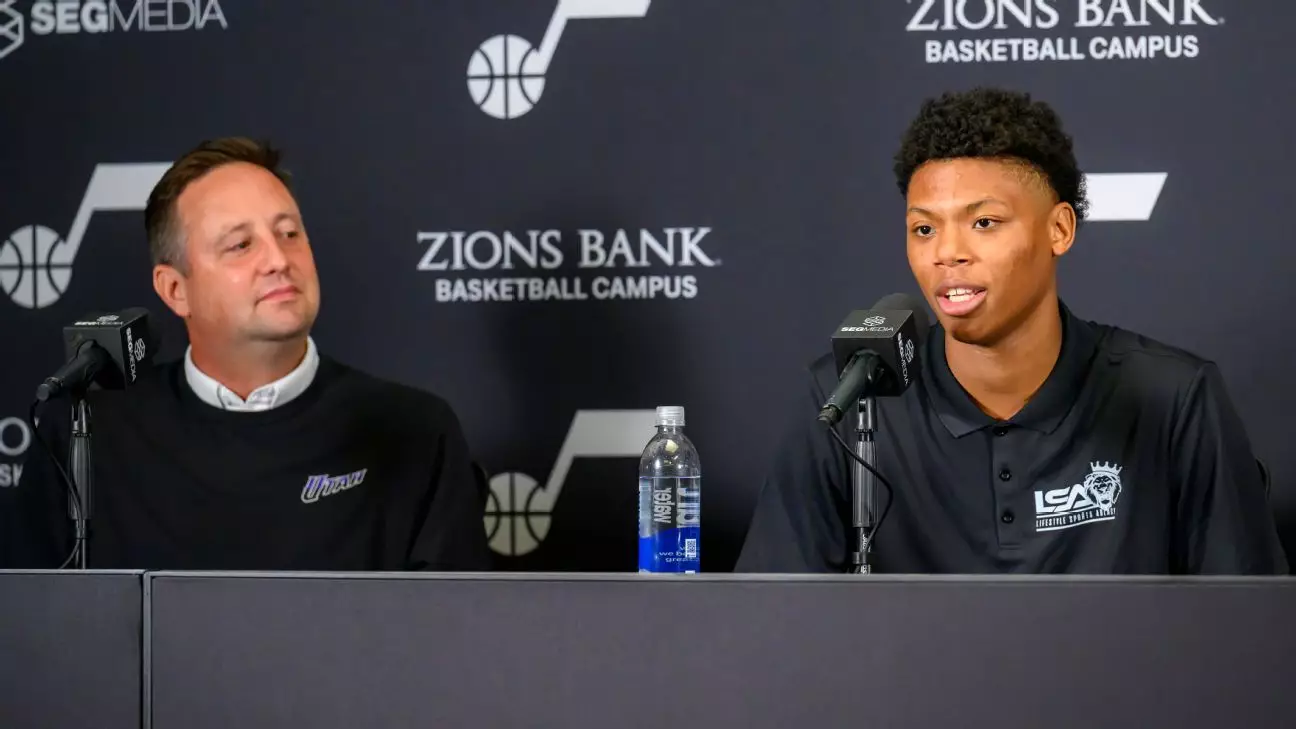Ace Bailey’s ascent into the NBA, marked by his selection as the fifth overall pick by the Utah Jazz, underscores a troubling tension in professional basketball’s talent evaluation system. Bailey’s story isn’t one of smooth scouting reports and eager workouts; rather, it’s a cautionary tale about how nonconformity and perception often outweigh raw talent and potential. Despite widespread criticism for his predraft approach—declining workouts with interested teams and predominantly eschewing traditional pre-draft rituals—Bailey showed a remarkable lack of resentment or entitlement. Instead, he expressed genuine gratitude and readiness to prove himself. This reaction might seem commendable on the surface, but it should also prompt a deeper analysis of the systemic issues in how young players are assessed and valued.
The Perils of the Pre-Draft Narrative
Before the draft, reports surfaced that Bailey was uncooperative, refusing workouts with the Philadelphia 76ers, Charlotte Hornets, and even Utah Jazz, the very team that eventually gambled on him. Such actions immediately tainted his image among scouts and executives, a reminder that the pre-draft process is as much about performative compliance as it is about actual aptitude. It’s baffling that a player with proven on-court impact—Bailey averaged 17.6 points and 7.2 rebounds in his only college season—found himself labelled as difficult or disinterested for choosing not to engage in what often feels like rote, scripted tryouts. This disparity makes it clear that the system excessively values scripted displays of cooperation over substantive basketball ability.
The irony lies in Utah’s willingness to overlook these concerns; they embraced Bailey’s undeniable potential and secured the pick that other teams seemed reluctant to use on him. This decision speaks volumes about a franchise’s readiness to challenge conventional wisdom, but also highlights how the draft can sometimes be a gamble based more on intuition than on a truly complete and fair evaluation of a player’s worth.
Untapped Versatility and the Misjudgment of Potential
Bailey’s offensive versatility is impressive and gives cause to believe that Utah’s gamble might pay off. Standing at 6-foot-8 with a skill set that includes shooting off the dribble, mid-range pull-ups, and an ability to attack the paint, Bailey represents a modern forward capable of stretching defenses while also contributing to rebounds and passing. His 34.6% three-point shooting at Rutgers reflects a willingness to evolve alongside the NBA’s pace-and-space style. The Jazz’s strategy of surrounding him with other high-scoring, multidimensional rookies like Walter Clayton Jr. and John Tonje can create a dynamic, versatile core that could overhaul their offensive identity.
However, the skepticism over Bailey’s draft slide—focused on concerns about his efficiency, ballhandling, passing, and defensive intensity—reflects a broader problem: the NBA’s obsession with upside sometimes conflates immediate readiness with maturity. Young players are too frequently penalized for aspects of their game that are well within the realm of coachable development. This hypercritical environment fosters a fear of risk-taking among teams, penalizing those who don’t adhere to conventional expectations.
The Need for a Paradigm Shift
What Ace Bailey’s drafting saga highlights is not just the individual player’s struggle but the flawed ecosystem that governs the transition from college to professional basketball. The predraft process often marginalizes young talents who choose to control their narratives and training on their own terms, reinforcing an elitist, corporate approach to athlete evaluation. Players like Bailey, who approach their career with a quiet confidence and a principled stance, frequently face unjust penalties in favor of those who excel in the prescribed performative rituals.
Utah’s bold decision to invest in Bailey reflects a commendable willingness to trust character and potential over the traditional metrics—yet their gamble is still framed by a system eager to spotlight conformity over individuality. If the NBA genuinely wants to harvest the richest pool of talent, it must begin by reevaluating how it defines “prospect value” and respect pathways that diverge from the norm.
Bailey’s assertion that “God didn’t put us here to be perfect” resonates not just as a message of self-acceptance but as a critique of a league’s near-obsession with perfection at the expense of human flaws and growth. This mindset should inspire the league, teams, and fans alike to foster an environment where players are granted the intellectual and emotional space to mature and prove themselves beyond the rigid frameworks of pre-draft optics.


Leave a Reply